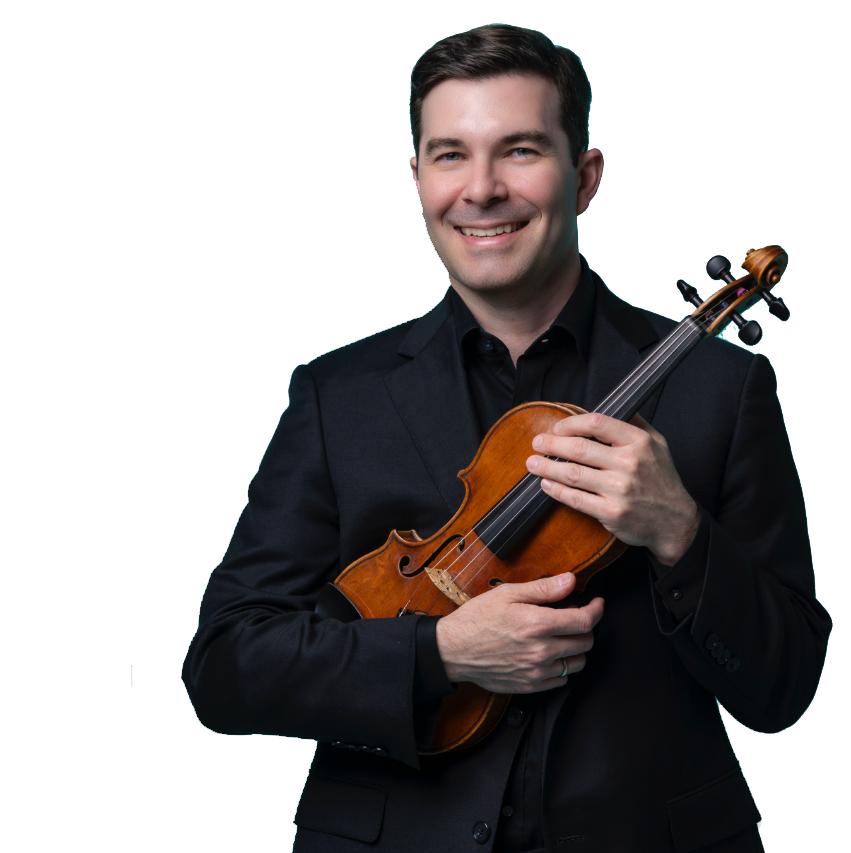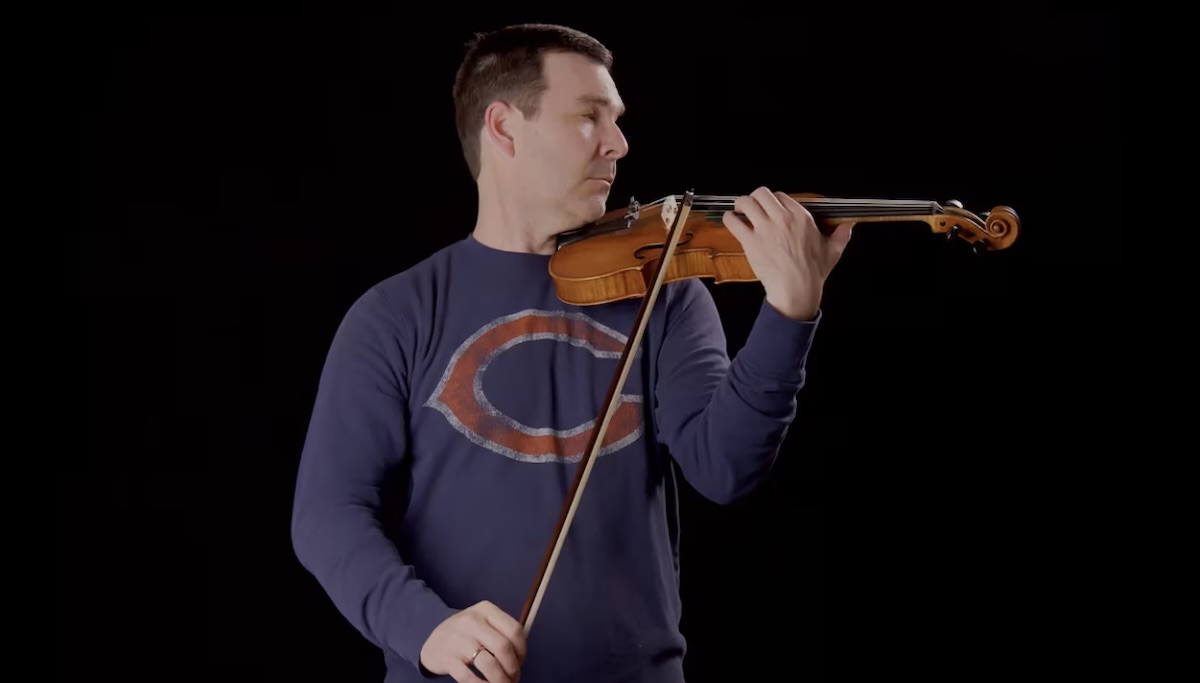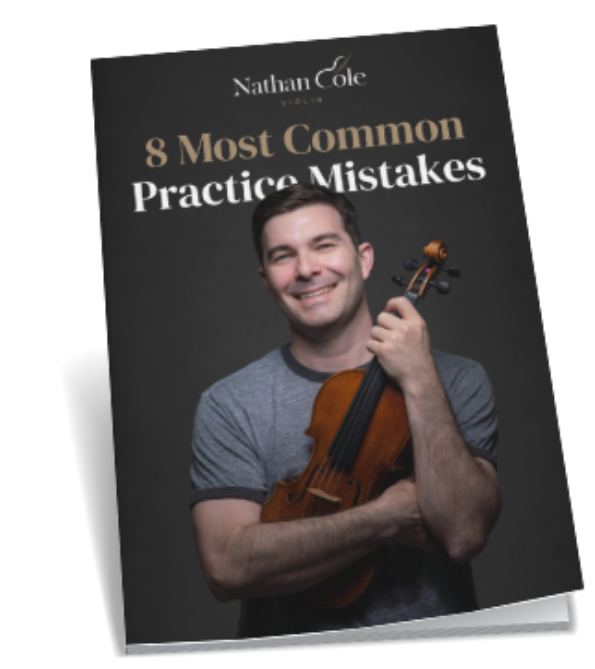Stacy LeSartre won my New York violin audition Challenge with an unexpected strategy

Week by week last fall, the number of violinists still remaining in my New York Philharmonic violin audition Challenge dwindled: sixty, thirty, twenty. By the time we got to the home stretch, the last few weeks of nearly four months of audition preparation, only fourteen violinists were left. It was pretty clear that those fourteen were going to take it to the finish. I wrote about thirteen of them here, and their stories are inspirational.
But there could be only one winner
I knew that the winner would be someone who had not only shown up without fail, uploading my video assignments on a weekly basis, but who had demonstrated a real mastery of the concepts. In short, my winner would be a player who had whipped herself into audition shape at the end of fifteen weeks. So when I viewed Stacy LeSartre’s final assignment, a one-take (first take, on the honor system!) video of the complete preliminary audition for the New York Philharmonic, my only disappointment was that she was playing for the camera and not for a real committee!
Instead, all of the Challengers were playing for me, hoping to score Challenge points. According to the rules, participants scored points for registering, completing assignments, showing improvement when pieces came back for a second assignment, and for standing out as my favorite video of the week. The biggest points, though, would come from two achievements: completing every single assignment on time; and delivering my favorite final video, to be recorded on the same day that the real New York audition candidates would be playing their preliminary round at Lincoln Center.
I quickly became overwhelmed keeping up with the various scoring categories, so I reluctantly eliminated the “most improved” points. Instead I awarded my “favorite” points for different reasons each week. Some weeks I rewarded accuracy; others, intuitive grasp of concepts; and still others, improvement. That way, the Challenge wouldn’t be dominated only by the strongest players.
But I had always planned on judging the final video as I would a professional audition. And going into that final week, there were four or five players in position to win. I knew that I was asking a lot for that final video, but I was confident (based on our fifteen weeks together) that everyone was as prepared as they could possibly be. I can tell you from personal experience that your heart starts racing when you hit “record” knowing that you’ve got one take and one take only, just like a real audition. Stacy showed great poise throughout her take, demonstrating the strength, style and control that committees want to hear in a preliminary round.
After I posted the final standings, I was eager to hear the stories of the fourteen violinists who had finished. I was especially interested in how Stacy had grown so dramatically during the Challenge. How had she stayed motivated for fifteen weeks, and how had she kept raising the level of her playing? I came away with two main reasons, and the second was quite surprising to me!
Stacy’s first advantage: fundamentals
Stacy embraced the fundamentals and worked on them the entire time. The very first week’s assignment was to record a selection of etudes, by Schradieck, Kreutzer and Dont. They focused mostly on left-hand technique: intonation, even-ness, and fluency. I chose them because I knew that many violinists neglect proper left-hand setup for years at a time, and they’re often startled at how quickly their technique improves once they start paying attention. Those who really understood the importance of these etudes knew that they would keep paying dividends for the duration of the Challenge.
Stacy said, “I discovered the need to be very persistent in pushing myself: from learning how to upload a file, to revisiting Schradieck, Kreutzer and Dont. As long as I kept pushing through all the resistance in the beginning, then my practice was better, and rewards were waiting. The [first week’s] repertoire strengthened my left hand for the excerpts and for everything I’m playing now. Schradieck turned out to be fun!”
Stacy’s second advantage: community
I had watched Stacy’s progress throughout the Challenge since she was a member of my school at ArtistWorks. Many of my members there were participating in the Challenge, so as I gave my feedback to them week by week, I was able to keep tabs on how they were doing. But I forgot about an interesting aspect of my school: members were actually able to keep tabs on each other!
At ArtistWorks, when a member posts a video to me, I respond with video feedback of my own, and the two videos are paired as an exchange. All violin members can watch all exchanges once they’re complete. And unbeknownst to me, Stacy was eagerly taking in the feedback that I gave, not only to her, but to the other Challengers who were part of ArtistWorks. “Once in the swing of the routine, the Challenge highlighted the parts of taking an audition that are enjoyable for me: hearing many violinists play the same repertoire; going into great depth with the excerpts; and playing for people,” she told me.
How community helps us
Stacy’s statement is powerful because she taps into that sense of community that most of us had when we started the violin. Unfortunately, most of us have lost that sense, at least when it comes to preparing for our performances and auditions.
To some extent that’s understandable. When it comes down to it, an audition is just you and your instrument, alone on a stage. Nobody else can play for you. Since in the end you must stand alone, it seems natural to prepare alone as well.
But have you noticed how often several students of the same teacher place at the same competition? Or how several finalists at an audition come from the same studio? It’s natural to blame politics or outright fraud for these results. But there is another explanation: these players prepared together, forming a community, and they strengthened each other along the way.
All of us who started the violin as part of a large studio, perhaps as part of the Suzuki method, benefited from this community whether we knew it or not. Week by week, we got to hear our friends play the same songs we played. We got to see and hear them perform, gradually getting used to that peculiar blend of excitement and dread: I hope they play their best…just not better than me!
And in the end, when it was our turn in the spotlight, it was comforting to know that we were part of a team. This ordeal, public performance, was something that all of us had to go through when our number was called, and so it was no big deal.
For those of us who went on to music school or conservatory, this feeling of shared experience continued: we encouraged each other in the practice room, joked about etudes and concertos over pizza, and cheered at each others’ recitals.
The alternative: isolation
Compare that with the sense of isolation most candidates feel during their audition preparation. They practically seal themselves off from the outside world for months leading up to the big day! They may play a mock audition, or two or three if they’re smart, but they are in essence flying solo, relying on their own energy and motivation to pull through. The very strongest players, technically and mentally, can make that work… but audition day doesn’t always go the way they want. What happens if their best isn’t good enough that day? Can they start over, alone, until they get a win? How much isolation can a musician take before just giving up?
That’s why Stacy was smart to learn not only from me, and from her own ears on a daily basis, but from her fellow Challengers. “It was great to be part of a large online community working towards the same goal,” she added. In the real world of professional auditions, it can be tough to seek out others who you’ll be competing against, but at the very least you can team up with someone else who is working toward a different performance around the same time as your audition. Even if your community is just you and one other violinist, you can lean on each other when times are tough. And that post-audition celebration is always sweeter when you aren’t drinking alone!
A winning attitude…
So what made Stacy take on the Challenge in the first place? “I had some unexpected downtime this summer and needed a project. The structure the Challenge offered was just right.” I like that attitude. Stacy’s willingness to take on a project on the spur of the moment speaks to her drive, and her results speak to her dedication.
…but not without obstacles
Stacy’s biggest difficulty during the Challenge was the same one the other finishers faced: time management. After the Challenge, in fact, I reassured all the participants that finding time to get things done remains my biggest obstacle. After all, I have three kids, all under 4 years old! So we all have different commitments, professional and personal. But if we want to reach our goals, we have to decide that they’re important to us and then make the time to move towards them.
Speaking to the time management issue, Stacy says, “Nathan came up with wonderful solutions to all the excerpts. But in order to make the solutions work consistently, I needed more practice. In the middle of the Challenge, my downtime was long gone, so fitting in practice for the Challenge was often a struggle. For me, an additional challenge was figuring out how to send in the video files. I was almost certain that would prevent me from finishing. But I’m happy to have kept at it until all the files went through. If I can overcome the uploads, I believe it’s possible for anyone with persistence to accomplish their repertoire goals on the violin.”
So who is Stacy?
I’ve waited until the end to tell you more about who Stacy is and what she does with the violin, because her strategy for the Challenge is something you can use to take your playing to the next level, no matter how long you’ve been playing. But here’s one last thing you should know about Stacy: she performs in front of people. A lot. And I believe that was the last piece of the puzzle for her. The camera doesn’t intimidate her because she puts herself out there on a regular basis. She is concertmaster of the Pro Musica Colorado Chamber Orchestra, Fort Collins Symphony Orchestra, Larimer Chorale Orchestra, and the Cheyenne Symphony Orchestra. She is also a substitute with the Colorado Symphony Orchestra.
Stacy’s LinkedIn profile
Pro Musica Colorado
Cheyenne Symphony Orchestra
Fort Collins Symphony Orchestra
If you missed the New York Philharmonic violin audition Challenge, why not go through it at your own pace? Read about the Challenge and how to start it today?

Scales: The Road
to Repertoire
Even if you’ve never played a scale before, violinist Nathan Cole of the Los Angeles Philharmonic will guide you through scale routines that meet you where you are, and build progressively alongside your playing.








Comment section